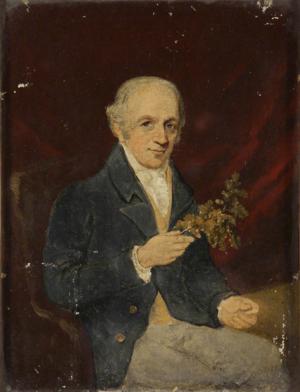Thomas Andrew Knight facts for kids
Quick facts for kids
Thomas Andrew Knight FRS
|
|
|---|---|

Thomas Andrew Knight, portrait by Solomon Cole (1806–1893), collection of Royal Botanic Gardens, Kew
|
|
| Born | 12 August 1759 Wormsley Grange, Herefordshire, England
|
| Died | 11 May 1838 London, England
|
| Nationality | English |
| Known for | plant breeding and selection |
| Children | Frances Acton Elizabeth Knight |
| Scientific career | |
| Fields | botanist |
| Author abbrev. (botany) | T.Knight |
Thomas Andrew Knight (1759–1838) was a famous British gardener and plant scientist. He lived in Herefordshire, England, at Elton Hall and later at Downton Castle. He was the second President of the Royal Horticultural Society from 1811 to 1838. This society helps people learn about and grow plants.
Contents
Early Life and Family
Thomas Andrew Knight was born in a place called Wormesley Grange. He was the second son of Rev. Thomas Knight. His family was quite well-known and wealthy. His older brother, Payne Knight, was a famous art collector. Payne Knight had inherited a lot of land and rebuilt Downton Hall into the beautiful Downton Castle. This wealth came from their grandfather, Richard Knight, who was a successful iron producer.
A Career in Plant Science
Thomas Andrew Knight went to Balliol College, Oxford to study. After finishing his studies, he became very interested in horticulture, which is the science of growing plants.
In 1795, he shared his findings about how to grow fruit trees and what diseases affected them. He used a large piece of land he owned to build a special curved greenhouse. Here, he grew and experimented with many plants, including strawberries, cabbages, and peas.
In 1797, he wrote a book called Treatise on the Culture of the Apple and Pear, and on the Manufacture of Cider and Perry. This book was very popular and helped people learn how to grow apples and make cider.
Plant Breeding and New Varieties
Knight was a pioneer in plant breeding. He would cross different types of plants to create new ones. He carefully selected the best seedlings from hundreds to find those with improved qualities. For example, he created the Siberian Harvey cider apple by choosing one of only four good seedlings from 300 crosses. His work on the sugar content of apple juice was also very important for the UK cider industry.
He also invented new tools for gardening and farming. These included a special drill for planting turnip seeds and a tool for growing pineapples.
Important Discoveries
Knight did many experiments on how plants work. He studied how gravity affects young plants (seedlings). He also looked into how diseases in fruit trees could spread through grafting. His main goal was always practical: to make food plants better by breeding them for stronger qualities. For a long time, the 'Downton' strawberry, which he developed, was a very popular strawberry in Britain.
Interestingly, Knight studied how peas changed over generations, much like Gregor Mendel did later. However, Knight didn't make the same big discoveries about how these changes were passed down. He preferred to work on his own, but he did write letters to other scientists around the world. He also met some of them when he visited London.
His research was highly respected by other scientists. Charles Darwin even mentioned Knight's breeding experiments in his famous book, The Origin of Species. Knight was made a member of the Royal Society in 1805 and won the Copley medal in 1806. He also received awards from agricultural and horticultural groups in many countries, including Europe, Russia, the USA, and Australia. Knight's apple seeds and plant cuttings were sent to the USA, which helped their apple industry grow.
Leading the Royal Horticultural Society
From 1811 to 1838, Thomas Andrew Knight was the president of the London Horticultural Society. This society was started in 1804. Sir Joseph Banks, who was the president of the Royal Society, saw how important Knight's work was. He asked Knight to join the Horticultural Society. After the first president passed away, Banks suggested Knight become the new president. In 1864, the society was allowed to call itself the Royal Horticultural Society.
Knight also helped write the "prospectus" for the society. This was like a mission statement that explained what the society would do. Younger members of the society, like Thomas Laxton, were inspired by Knight's work. Laxton used Knight's careful methods to create better varieties of apples, peas, and sweet peas. He also built a successful seed business.
Family Life
Thomas Andrew Knight married Frances Felton. They had several children:
- Thomas Andrew Knight, their oldest son, who passed away before his father.
- Frances Knight (d. 1874), who was a botanist, writer, and artist.
- Elizabeth Knight (d. 1860), who married Francis Walpole.
- Charlotte Knight (c. 1801–1842), who was also a notable gardener. She inherited her father's Downton Castle estate.
Death
Thomas Andrew Knight passed away in 1838. He was buried in the churchyard of St Mary's Church, Wormsley. His tomb there is still a protected historical structure.




